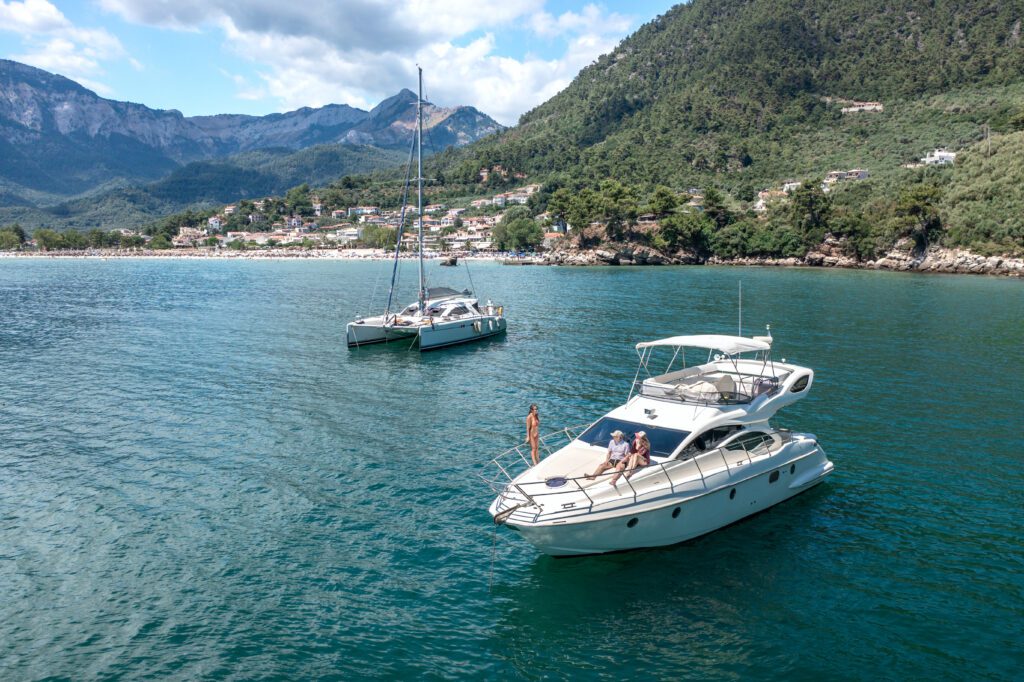Publication date: 04/29/2024
The end of wintering, or the promise of new navigations
Summer: a busy sailing season
Winter conditions don’t really lend themselves to sea outings. With the shorter days, lack of sunshine and often capricious weather, you’ve probably decided to winterize your unit for these few months of the year.
For many boaters, March-April is the end of wintering, and the time to get back underway. Owners are hard at work getting their boats ready for the summer season. We all know it: every year, the few sunny months go by very quickly, and you can’t wait to get the most out of your unit, whether at sea or on the river!
A must: anticipate before launching back into the water
The first sailing date of the year officially defines the start of the boating season for every boater. When the boat has been stored ashore for the winter, launching is an important moment. When the motorboat or sailboat has been wintered in the water, in a marina for example, it is the moment when the boat’s annual maintenance is completed, and it is ready to sail.
Regardless of the type of water your boat will be sailing on, it’s essential to prepare it properly: de-wintering a boat with the utmost care allows you to take full advantage of your future experiences on the water, by ensuring that you take to the sea in the best possible conditions. This operation is sure to concern you, whatever your type of boat …
De-wintering steps for a motorboat or sailboat
Checking in- and out-of-water components
Wintering a boat, whether in the water, in a marina, or in the dry, on a quay or on racks, inevitably means that your boat will be out of service for several months. So the first step in getting your boat back into service at the start of the summer season is to carry out a number of essential checks. All components of your motorboat or sailboat, whatever they may be, must be checked! To avoid any subsequent inconvenience or risk on board, you’ll need to follow a number of checkpoints. The boat must be inspected in detail, so that nothing is left to chance…
If the vessel has been stored out of the water, this is a particularly good time to carry out a visual inspection of the hull. Check its condition: is it cracked or diseased? Are there any repairs to be made, such as to the gelcoat? If you have an inboard motor, take the opportunity to inspect the shaft line and stuffing box.
When de-winterizing a boat, it’s also important to check all engine systems thoroughly: spark plugs, transmission system, cooling system, fluid levels… but also the alternator belt, exhaust elbows, hoses and manifolds!
Electronics, too, need to be checked: are on-board instruments and navigation equipment, for example, in working order? Do navigation and anchor lights work properly?
You should also check the condition of the batteries. If you’ve left them in for the winter, charge them before putting them back in. What is the recharging capacity? What is the discharge rate? Check the condition of the cables and terminals, and the electrolyte level.
If the boat has been in the water for the winter, inspect the bottom for any traces of moisture. If the boat has been stored in the dry, check for leaks when you put it back in the water. Always check that valves are working, that seals are effective and that through-hull fittings, in particular, are not attacked by corrosion or electrolysis… Also make sure that your main bilge pump is working, as well as any secondary pumps!
Maintenance tasks to be carried out before returning to the water
If you have small jobs to do on your motorboat or sailboat, take advantage of the pre-season period: marina berths are not yet very busy and, if you need them, yachting professionals often still have availability.
When it comes to maintenance tasks, the first step in commissioning a boat is to get the engine running again. Whether your boat is equipped with an inboard or outboard motor, you’ll need to carry out thorough engine maintenance: after checking all the above points, make any necessary oil, filter or spark plug changes.

Take advantage of your unit’s return to service to carry out all the maintenance operations you won’t be able to take the time to perform this summer: grease winches, pulleys, electrical system terminals… Lubricating these components will keep them in good working order over time, notably by preventing corrosion. On deck, your maneuvers will be much easier!
Also check the condition of mooring lines, whether they have been used over winter or stored. If you own a sailboat, check the running and standing rigging, and replace any halyards or sheets no longer in good condition. Think about your sails too: do you need to repair worn parts, or darn tears?
Finally, at the start of the season, just before launching, we recommend that you refit your boat. If it has been wintered in water, this step will enable you to carry out the hull and propulsion inspection mentioned in the previous point!
Clean and prepare the substrate, then apply the antifouling paint. In this way, you’ll prevent the appearance of marine growth on your boat’s hull, and enjoy smoother sailing throughout the summer.
Finally, if you find that the anodes are too damaged, you can replace them. This is essential to prevent the appearance of disease on your boat!
Seasonal cleaning of your unit
At the end of the wintering period, there’s always the need for cleaning. On the outside, the deck, cockpit, roof glazing and deck hatches, in particular, deserve to be pampered. Inside, the cabins, galley, head compartments and saloon fittings also need dusting. Depending on your use, this may also be a good time to clean the ship’s freshwater tank(s)!
Once you’ve completed your thorough cleaning, you can move on to preparing the boat’s interior. By optimizing your on-board stowage, you’ll be able to sail with peace of mind all summer long. A few specific installations can also make your life on board easier…
The moment of rearmament
Have you checked all the elements? Once you’ve done that, it’s time to rearm your unit. Perhaps you’ve removed everything you didn’t use over the winter, and stored it at home or elsewhere? Then it’s time to re-equip your ship for summer!
Reinstall anything you may have dropped off, as well as any valuables you may have removed for use on board. Electronic equipment, for example, often brings comfort and security on board.
Think about the ship’s basic supplies, and prepare reserves for food and hydration in case of problems: some freeze-dried or canned food that can be stored for the long term, and extra water!
Last but not least, fill up with water and fuel – diesel or diesel oil, for your main engine and possibly for the outboard of your tender. Have you thought about the gas bottle for your gas stove, barbecue or fridge?
Don’t forget to check your safety equipment
Before your first outing, we also recommend that you take the time to check your safety equipment.
Check the validity of each item by checking the expiration date: distress flares, fire extinguishers, first-aid kit items… Is your life raft up to date, too? Does it need servicing? Do you have on board all the equipment required by Division 240 for the intended navigation zone?
Among your safety equipment, the VHF is also an essential resource, and it’s vital to check that it’s working properly. Are your towing device and mooring kit still in good condition? If you’ve made any modifications to your unit, are they still fit for purpose?
Last step on your wintering trip: you can take on board a few spare fittings and light bulbs, so you can intervene if necessary.

By following these tips, you should soon be ready to take the helm of your motorboat or sailboat again, for safe and comfortable sailing this summer.
Need help checking or refurbishing your unit before the next season? At every port in the Port Adhoc network, boating professionals are on hand to help. Contact our team – we’ll be delighted to help!
➡️ Read also: Our marinas and ports for a sailing season in France
